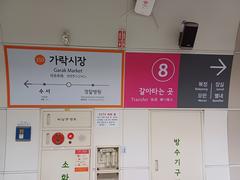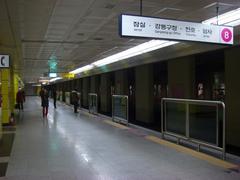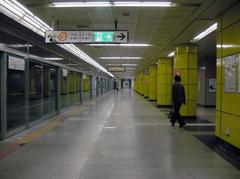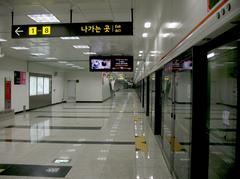
Garak Market Station Seoul: Visiting Hours, Tickets, and Travel Guide
Date: 14/06/2025
Introduction
Garak Market, located in the Songpa District of southeastern Seoul, is one of South Korea’s largest and most historically significant food markets. Established in the 1980s to centralize and modernize Seoul’s food distribution, Garak Market has transformed over decades into a vibrant hub of commerce, culinary exploration, and cultural exchange. Today, it seamlessly blends its wholesale operations with retail pavilions, educational programs, and direct subway access via Garak Market Station on Lines 3 and 8. This comprehensive guide covers Garak Market’s history, structure, visiting hours, ticketing, accessibility, unique experiences, and travel tips—ensuring you get the most from your visit (e-architect; Seoul Metropolitan Government; Visit Seoul; Wikipedia).
Table of Contents
- Introduction
- Historical Evolution of Garak Market
- Market Structure and Zoning
- Economic and Cultural Significance
- Modernization and Urban Integration
- Visitor Information
- Unique Experiences and Special Events
- Nearby Attractions
- Frequently Asked Questions (FAQ)
- Conclusion
- References
Historical Evolution of Garak Market
Origins and Development
Garak Market was conceived in the early 1980s to address the logistical and safety challenges posed by Seoul’s previously scattered food markets. Strategically positioned near major highways and the Han River, it became the first public wholesale market in Korea, revolutionizing agricultural and fisheries trade with an auction-based system that increased transparency, stabilized prices, and streamlined distribution (e-architect).
Expansion and Redevelopment
By the early 2000s, Garak Market had grown into South Korea’s largest wholesale market, expanding its footprint and facilities to accommodate high trading volumes. However, issues like congestion, environmental concerns, and outdated infrastructure necessitated major redevelopment. In 2009, a comprehensive redesign by Samoo Architects & Engineers introduced eco-friendly logistics, a rooftop park, improved auction and storage facilities, and a pedestrian-friendly layout that opens the market toward the Han River and local neighborhoods (e-architect).
Integration with Public Transit
The market’s direct connection to Garak Market Station (Lines 3 and 8) has made it even more accessible, reducing road traffic and integrating the market into Seoul’s urban mobility network (Wikipedia).
Market Structure and Zoning
Garak Market covers over 540,000 square meters with a modern Garak Mall and a traditional wholesale market, each subdivided for efficiency and convenience (Visit Korea; Kpopmap).
Garak Mall (Modern Section)
- Store Zone: Over 1,100 shops selling fresh produce, seafood, meat, dried goods, and kitchenware (Visit Seoul; KoreaToDo).
- Theme Zone: Five themed buildings hosting food tastings, culinary experiences, and cultural programs.
- Task Zone: Facilities include a library, cooking studio, convention center, hospital, bank, and childcare services (Visit Seoul).
Floor Guide:
- B2: Meat section
- B1: Fruits and vegetables
- 1F: Live seafood market with on-site preparation options
- 2F: Dried seafood and kitchenware
- 3F: Restaurants specializing in seafood dishes (KoreaToDo)
Garak Wholesale Market (Traditional Section)
- Agricultural Market: The largest area, with over 1,300 stalls selling produce—about 90% of market transactions.
- Fishery Market: Renowned for early-morning seafood auctions (2:00–5:00 a.m.).
- Livestock Market: Smaller, with auctions at 10:30 a.m. and 2:30 p.m. (Kpopmap).
Navigation: Use bilingual signage and online market maps, or take the cyber tour via the Garak Mall website (Visit Seoul).
Economic and Cultural Significance
Garak Market is a cornerstone of Korea’s food supply chain, handling over 7,000 tons of goods daily and facilitating transactions of 10.4 billion KRW. It supports thousands of farmers, fishers, and local businesses, while serving as a vital source of fresh ingredients for Seoul’s restaurants, homes, and vendors (Seoul Metropolitan Government; The Soul of Seoul).
Culturally, Garak Market preserves Korean food traditions through live auctions, seasonal festivals, cooking classes, and educational programs. Its lively atmosphere and bustling retail areas offer a window into Korea’s daily life and culinary heritage (Visit Seoul).
Modernization and Urban Integration
- Redevelopment: Since 2011, Garak Market has been modernized into Garak Mall, with enhanced logistics, eco-friendly lighting, and a rooftop park for recreation and cultural events (e-architect).
- Community Facilities: The market now includes a library, cooking studio, convention center, and accessible amenities.
- Urban Connectivity: The integration with subway lines and bus routes reflects Seoul’s push for sustainable, multifunctional urban spaces.
Visitor Information
Visiting Hours and Days
- Agricultural & Fishery Markets: Open 24 hours except Sundays, New Year’s Day, Seollal, and Chuseok (Visit Korea).
- Livestock Market: 4:00 a.m. – 10:00 p.m., closed Sundays and major holidays.
- Retail and Restaurants: Generally open 6:00 a.m. – 10:00 p.m.
- Auctions:
- Vegetable: 6:00 p.m. – 9:00 p.m.
- Fishery: 1:00 a.m. – 3:30 a.m.
- Livestock: 10:30 a.m. and 2:30 p.m.
Ticketing and Entry
- Admission: Free for all visitors. Some cooking programs or tours may require booking and a fee.
Accessibility and Transportation
- Subway: Garak Market Station (Lines 3 & 8), direct exits into the market.
- Bus: Numerous city and intercity lines stop nearby.
- Parking: Over 2,000 spaces; first 15 minutes free, then charged incrementally (Kpopmap).
- Taxi: 30–40 minutes from central Seoul; fares range 15,000–25,000 KRW.
- Accessibility: Elevators, ramps, tactile paving, accessible restrooms, and wide ticket gates at the station.
Facilities and Services
- Dining: Eateries and food stalls throughout, with many restaurants preparing seafood purchased on-site (KoreaToDo).
- Other Amenities: Library, cooking studio, bank, hospital, childcare, ATMs, and convenience stores.
- Rest Areas: Benches and shaded spaces are available.
Tips for Visitors
- Plan Your Route: Use market maps or the online cyber tour.
- Language: Basic English signage; most vendors speak Korean—translation apps are helpful.
- Payment: Cash preferred, some card acceptance; ATMs on-site.
- Dress Comfortably: Wear walking shoes; the market is extensive.
- Photography: Always ask permission before taking photos, especially during auctions.
- Peak Times: Early morning for auctions and freshest goods; afternoons are generally less crowded.
Unique Experiences and Special Events
- Wholesale Auctions: Witness the energy of seafood and produce auctions at dawn.
- Food Sampling: Try local specialties and seasonal fruits.
- Cooking Classes: Join hands-on sessions using market-fresh ingredients.
- Festivals: Attend seasonal events, especially around Chuseok and Lunar New Year.
- Guided Tours: Available through local operators and occasionally the market (Visit Seoul).
Nearby Attractions
- Lotte World Tower: Panoramic city views and shopping.
- Seokchon Lake Park: Serene walking trails.
- Olympic Park: Outdoor sculptures and cultural events.
- Songpa Naru Park: Venue for festivals and leisure.
Frequently Asked Questions (FAQ)
Q: What are the best Garak Market visiting hours?
A: Early morning (5:00–8:00 a.m.) for auctions and fresh produce; afternoons for a quieter experience.
Q: Is there an entry fee?
A: No, admission is free. Special programs may require a ticket.
Q: How do I get to Garak Market?
A: Take Seoul Subway Line 3 or 8 to Garak Market Station, or use city buses and taxis.
Q: Is Garak Market accessible for disabled visitors?
A: Yes, with elevators, ramps, accessible restrooms, and wide aisles.
Q: Are guided tours available?
A: Yes, through local tour agencies and sometimes by the market itself.
Conclusion
Garak Market is much more than a wholesale market—it’s a vibrant confluence of tradition, commerce, and innovation. Its pivotal role in Korea’s food system, dynamic atmosphere, and seamless integration with Seoul’s urban infrastructure make it a must-visit destination for anyone interested in authentic Korean culture and cuisine. With extensive facilities, free admission, and proximity to major attractions, Garak Market is the perfect place to immerse yourself in Seoul’s culinary heartbeat.
Download the Audiala app for interactive maps, real-time updates, and exclusive guided experiences. Follow us on social media for the latest news, tips, and upcoming events to enrich your visit.
References
- e-architect: Garak Market Seoul
- Seoul Metropolitan Government: Innovation of Distribution of Agricultural and Fisheries Products – Garak Market
- Visit Seoul: Garak Mall
- Wikipedia: Garak Market Station
- Visit Korea: Garak Market
- Kpopmap: Garak Market
- The Soul of Seoul: The Best Traditional Markets in Seoul
- KoreaToDo: Garak Market
- The Seoul Guide: Garak Mall
- Seoulistic: Garak Market
- Seoul Transport Operation & Information Service
- Stars and Stripes Korea: Traveling from Pyeongtaek to Seoul by Express Bus
















































































































































































































